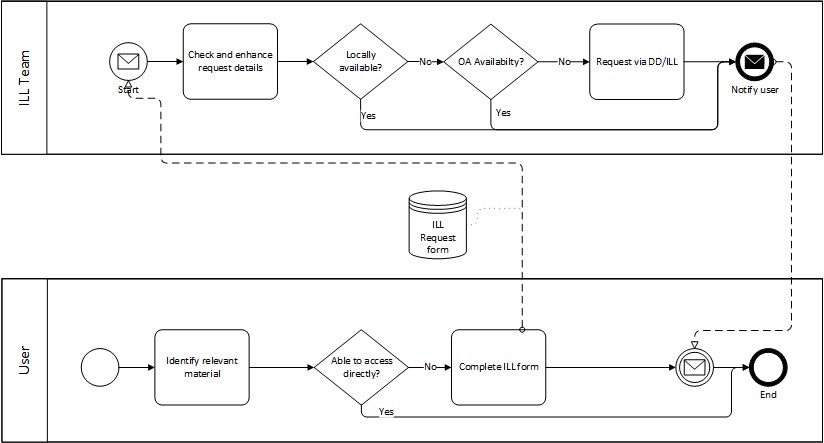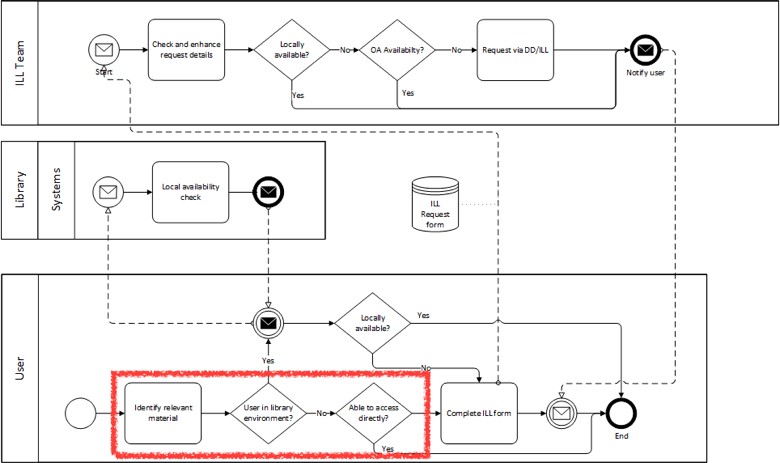Work is continuing apace on the Jisc OA Open Access Button project which is assessing the feasibility of a service in the discovery/ interlibrary loan (ILL) workflow utilising Open Access Button functionality to aid the discovery, creation and promotion of open access content. The first phase of work being undertaken by SeroHE and Open Access Button is nearing completion, so it’s high time for an update on what we have learnt in terms of use-cases for a potential service, and how we are investigating these in more detail in collaboration with our case study institutions – which we are delighted to confirm as the University of York, University of Huddersfield and Imperial College London.
Identifying use-cases
The project team has been looking at ways in which the creation of a possible service could deliver the most benefit to the most institutions by developing use-cases to articulate where the service could sit within the discovery/interlibrary loan (ILL) workflow. The first task therefore was to understand how the workflow currently looked:

This diagram shows a simplified discovery (user identifying material of interest to them) to deliver (user accessing material) process. It assumes that OA availability of the item is checked by the ILL team, although this is not true (or not consistently true) across the sites we have talked to. It is worth noting that the point at which the user isn’t able to directly access the material is probably a point where many users drop out of the process – most won’t go on to make an ILL request.
Our first two use-cases focused on how OAB functionality could be slotted into the back-office functions of the library ILL process, as part of the manual check or by integrating within an automated process that takes place within the ILL team. We also considered how integration might be included within ILL submission form, so that rather than wait for the request to reach the ILL process, it would be possible to immediately feedback to the user that the item is available as OA, so potentially avoiding the need for the request to be processed.
However, based on the input of the advisory group and our interviews with institutions to date, we have a clear steer that the priority is to look at the ways in which we can push open access content directly to the user during their discovery process, well before they reach the inter-library loan procedure in the library. This would potentially integrate Open Access Button functionality in the user’s environment so that no matter whether the user is working in a library controlled environment or coming through some other route (e.g. Google), we could help direct them to the material if it is available. Once the library has an option to deliver services to a user within the browser, this could also open other options/possibilities – including check for local access (subscriptions etc.) and/or authentication help (e.g. pushing requests via EZProxy). This is best illustrated using the diagram below:

Working with case-study institutions
We are delighted to say that we received an overwhelming response to the project, but were unfortunately only able to take through three institutions to be case studies: the University of York, University of Huddersfield and Imperial College London. Within our (admittedly small) group, we tried to cover a range of institution sizes and research focus, use-case interest and LMS technology. However, we also had to make choices based on tight practical constraints such as the institution’s ability to commit time, expertise, and iterative feedback. Throughout, we’re working to make sure these case-studies are mutually beneficial to all involved, whatever their outcome.
Through our case studies, we’re looking for deeper and more practical insights and approaches to fulfilling all the use-cases mentioned. With Imperial College London, we’ve looked at using an “Open Access Button-like” plugin on campuses PC, and users machines, to provide one click access to subscription content, self-archived Open Access materials and the ILL system. At York, we’re trying to explore how to provide existing Open Access content into library search, link resolvers, while providing seamless access to the ILL system and Open Access Button requests. Finally, at Huddersfield, we’re working to simplify and enhance ILL forms, while streamlining ILL staff workflows.
What’s next?
SeroHE are now in the process of writing up the evidence they have gathered from institutions on their requirement for a potential service and what delivery options for that service might be. They continue to work closely with Open Access Button as they carry on working with the case study institutions to assess the practical feasibility of some of the use-case options outlined above.
We hope to be able to report back to the community on our complete findings in the late summer. It is worth noting at this stage that this is fast-moving area for development so this, along with the range of evidence gathered, will influence our assessment of whether there is value in developing any potential service further.
